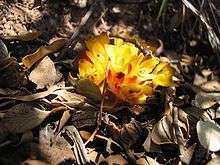Cytinus hypocistis
Cytinus hypocistis is an ant-pollinated[4] species of parasitic plant in the family Cytinaceae having four subspecies. It is found primarily in locations that surround the Mediterranean Sea,[5] and is the type for the genus Cytinus.[6] The binomial has been conserved.[6]
| Cytinus hypocistis | |
|---|---|
 | |
| C. hypocistis growing under a bush in leaf litter, near Fréjus in the south of France | |
| Scientific classification | |
| Kingdom: | Plantae |
| Clade: | Tracheophytes |
| Clade: | Angiosperms |
| Clade: | Eudicots |
| Clade: | Rosids |
| Order: | Malvales |
| Family: | Cytinaceae |
| Genus: | Cytinus |
| Species: | C. hypocistis |
| Binomial name | |
| Cytinus hypocistis | |
| Subspecies[2] | |
| Synonyms[1][3] | |
| |
Distribution
Cytinus hypocistis is native to Albania; Algeria; Crete; Croatia; Cyprus; Greece; France (including Corsica); Israel; Italy (including Sardinia and Sicily); Lebanon; Libya; Malta; Morocco; Portugal; Spain (including both the Balearic and Canary Islands); Syria; Tunisia; and Turkey.[5]
The subspecies macranthus is native to Portugal and western Spain; orientalis is native to southern Greece and Crete; and pityusensis is endemic to Ibiza of the Balearic Islands.[2]
Uses
Cytinus hypocistis has been used in traditional medicine to treat dysentery and tumors of the throat, and has been used for its astringent qualities.[7]
| Wikimedia Commons has media related to Cytinus hypocistis. |
References
- Under its currently accepted binomial (Cytinus hyocistis), from its basionym (Asarum hypocistis), this species was first published in Genera Plantarum Eorumque Characteres Naturales Secundum Numerum, Figuram, Situm, & Proportionem Omnium Fructificationis Partium. (Ed. 6). Stockholm. 6. 576 ["566"]. 1764. "Plant Name Details for Cytinus hypocistis". IPNI. Retrieved November 15, 2012.
- "Flora Europaea Search Results for hypocistis and Cytinus". Flora Europaea. Royal Botanic Garden Edinburgh. Retrieved November 15, 2012.
- This species, originally as Asarum hypocistis, was first described and published in Species Plantarum 1: 442. 1753. "Plant Name Details for Asarum hypocistis". IPNI. Retrieved November 15, 2012.
- Clara de Vega; Montserrat Arista; Pedro L. Ortiz; Carlos M. Herrera; Salvador Talavera (May 2009). "The ant-pollination system of Cytinus hypocistis (Cytinaceae), a Mediterranean root holoparasite". Annals of Botany. 103 (7): 1065–1075. doi:10.1093/aob/mcp049. PMC 2707910. PMID 19258337.
- "Cytinus hypocistis". Germplasm Resources Information Network (GRIN). Agricultural Research Service (ARS), United States Department of Agriculture (USDA). Retrieved November 15, 2012.
- "Name - !Cytinus L." Tropicos. Saint Louis, Missouri: Missouri Botanical Garden. Retrieved November 15, 2012.
T: Cytinus hypocistis (L.) L.; annotation: nom. cons.
- James A. Duke. "Cytinus hypocistis (RAFFLESIACEAE)". Dr. Duke's Phytochemical and Ethnobotanical Databases. Archived from the original on September 23, 2015. Retrieved November 15, 2012.